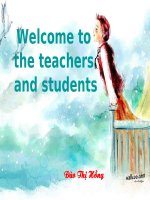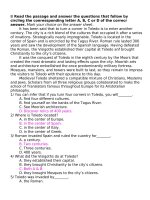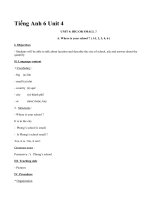TIENG ANH 10 UNIT 4 READING RAT HAY
Bạn đang xem bản rút gọn của tài liệu. Xem và tải ngay bản đầy đủ của tài liệu tại đây (2.27 MB, 17 trang )
to our class
The boy can not hear. Can you
guess his disability?
He is
deaf.
He is blind.
They are
the dumb.
Look at these pictures
Who are
they?
What
are they
doing?
Where are
they?
They are
disabled
children.
They are
in class
They are
learning
Unit 4
Special Education
Reading
Vocabulary
1. blind ( a ) [ blaind ]:
2. deaf ( a ) [ def ] :
3. dumb (a) [d mʌ ]:
4. oppose to ( v) [ə'pouz ]:
5. opposition ( n ) [, pə'zi∫n]ɔ :
6. arm ( n ) [ :mɑ ]:
7. finger ( n ) ['fiηgə]:
8. Effort ( n ) ['efət]:
mù
điếc
câm
phản đối
sự phản đối
bàn tay
ngón tay
cố gắng
9. To be proud of ( a ): tự hào
eg: The children have every reason to be proud of their
efforts.
*
*
*
Vocabularies
disabled (adj)
khuy t t tế ậ
Gradually (adv)
dần dần
mentally retarded (adj)
thiểu năng
time-consuming (adj)
tốn thời gian
demonstration (n)
cách diễn đạt
make great efforts (v)
nỗ lực
prevent … from + V-ing
cản trở
Task 1:
Match the words or phrases in A with their meanings in
B.
A
1. disabled
2. mentally retarded
3. time-consuming
4. demonstration
5. gradually
B
a. Taking or needing a lot of
time
b. An act of showing or
explaining how to do st
c. Unable to use a part of
the body in the normal way
d. Slowly, over a long period
of time
e. Less mentally developed
than normal
Task 2: Read the passage again and complete the
following sentences by circling the corresponding
letter A, B, C or D.
1.Thuy’s class is different from other classes
because the children __________.
A
B
C
D
are from large families
are less mentally developed
love math very much
are disabled
2. At first the parents were _____ the idea of
sending their children to the special class.
A
B
C
D
interested in
opposed to
satisfied with
worried about
Task 2: Read the passage again and complete the
following sentences by circling the corresponding
letter A, B, C or D.
3. It can be inferred from the second
paragraph of the reading passage that there
has been__________ .
A
B
C
D
a change in the parents’ attitude towards the class
a lot of protest from the parents against the class
a feeling of doubt in the teacher’s ability
a belief in the parents’ opposition
Task 2: Read the passage again and complete the
following sentences by circling the corresponding letter A,
B, C or D.
4. The writer describes how Thuy teaches the
children to add and subtract in oder to prove that
___.
A
B
C
D
the children like Maths
the teacher is proud of her work
the teaching work takes time
adding and subtracting are important
Task 2: Read the passage again and complete the
following sentences by circling the corresponding letter A,
B, C or D.
5. The writer’s attitude towards Thuy’s work in the
passage can be described as ___.
A
B
C
D
humorous
angry
suspicious
admiring
Task 2: Read the passage again and complete the
following sentences by circling the corresponding letter A,
B, C or D.
After you read: Fill each the blanks of the summary below with a
suitable word from the box.
read write disabled efforts opposition
time- consuming Maths arms fingers proud
Twenty-five ……………children have the chance of learning
how to ………….and ……………. thanks to the …………….of a
young teacher, Pham Thu Thuy.
Although her idea, at first, met with……………… from the
parents of the disabled children, more children attended her
class later.
The teaching work in the special class is ……………………For
example, in a ………………lesson, the teacher has to use
her…………….and ………….to teach the children how to add
and subtract. The children are now ……………and happy.
( adj )
( v )
( v ) ( n )
( n )
( adj )
( n )
( n )
( n )
( adj )
(1)
(2)
(3) (4)
(5)
(6)
(7)
(8) (9)
(10)
disabled
read
write
efforts
opposition
time-consuming
Maths
arms
fingers
proud
After you read:
Fill each the blanks of the summary below with a suitable word from the box
2
9
5
3
7
8
4
10
6
1010
-
Learn new words by heart
-
Think of what you should do to help
the disabled
-
Prepare new lesson
Homework:









